wheel SATURN VUE HYBRID 2009 User Guide
[x] Cancel search | Manufacturer: SATURN, Model Year: 2009, Model line: VUE HYBRID, Model: SATURN VUE HYBRID 2009Pages: 346, PDF Size: 2.1 MB
Page 93 of 346
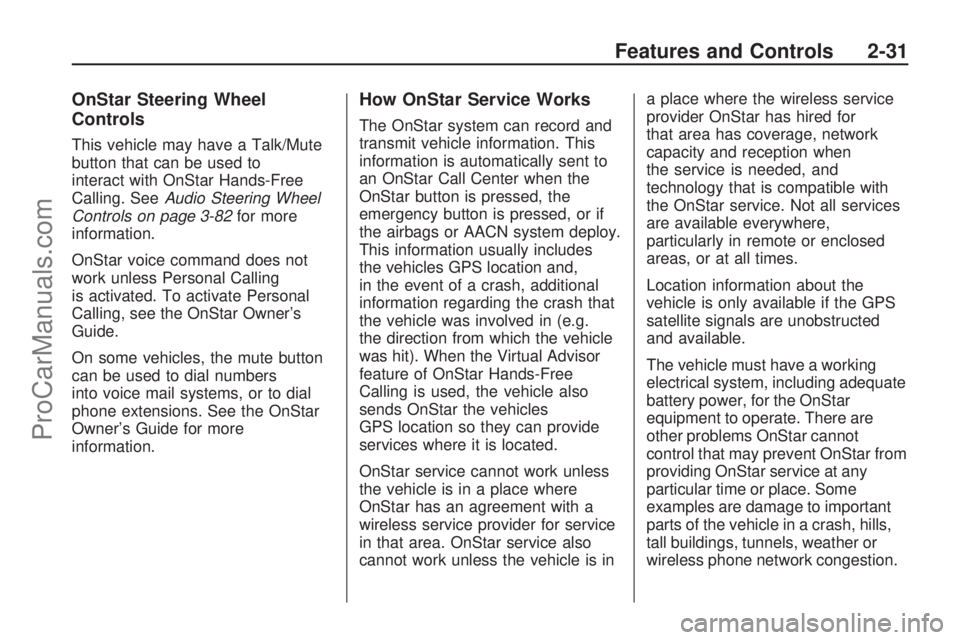
OnStar Steering Wheel
Controls
This vehicle may have a Talk/Mute
button that can be used to
interact with OnStar Hands-Free
Calling. SeeAudio Steering Wheel
Controls on page 3-82for more
information.
OnStar voice command does not
work unless Personal Calling
is activated. To activate Personal
Calling, see the OnStar Owner’s
Guide.
On some vehicles, the mute button
can be used to dial numbers
into voice mail systems, or to dial
phone extensions. See the OnStar
Owner’s Guide for more
information.
How OnStar Service Works
The OnStar system can record and
transmit vehicle information. This
information is automatically sent to
an OnStar Call Center when the
OnStar button is pressed, the
emergency button is pressed, or if
the airbags or AACN system deploy.
This information usually includes
the vehicles GPS location and,
in the event of a crash, additional
information regarding the crash that
the vehicle was involved in (e.g.
the direction from which the vehicle
was hit). When the Virtual Advisor
feature of OnStar Hands-Free
Calling is used, the vehicle also
sends OnStar the vehicles
GPS location so they can provide
services where it is located.
OnStar service cannot work unless
the vehicle is in a place where
OnStar has an agreement with a
wireless service provider for service
in that area. OnStar service also
cannot work unless the vehicle is ina place where the wireless service
provider OnStar has hired for
that area has coverage, network
capacity and reception when
the service is needed, and
technology that is compatible with
the OnStar service. Not all services
are available everywhere,
particularly in remote or enclosed
areas, or at all times.
Location information about the
vehicle is only available if the GPS
satellite signals are unobstructed
and available.
The vehicle must have a working
electrical system, including adequate
battery power, for the OnStar
equipment to operate. There are
other problems OnStar cannot
control that may prevent OnStar from
providing OnStar service at any
particular time or place. Some
examples are damage to important
parts of the vehicle in a crash, hills,
tall buildings, tunnels, weather or
wireless phone network congestion.
Features and Controls 2-31
ProCarManuals.com
Page 100 of 346
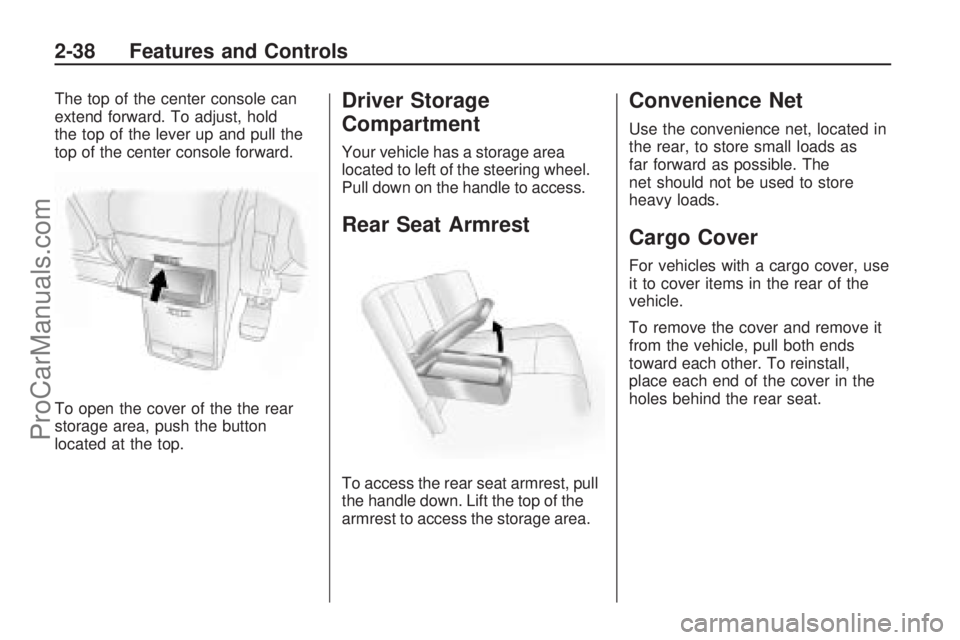
The top of the center console can
extend forward. To adjust, hold
the top of the lever up and pull the
top of the center console forward.
To open the cover of the the rear
storage area, push the button
located at the top.Driver Storage
Compartment
Your vehicle has a storage area
located to left of the steering wheel.
Pull down on the handle to access.
Rear Seat Armrest
To access the rear seat armrest, pull
the handle down. Lift the top of the
armrest to access the storage area.
Convenience Net
Use the convenience net, located in
the rear, to store small loads as
far forward as possible. The
net should not be used to store
heavy loads.
Cargo Cover
For vehicles with a cargo cover, use
it to cover items in the rear of the
vehicle.
To remove the cover and remove it
from the vehicle, pull both ends
toward each other. To reinstall,
place each end of the cover in the
holes behind the rear seat.
2-38 Features and Controls
ProCarManuals.com
Page 103 of 346

Instrument Panel
Instrument Panel
Overview
Instrument Panel
Overview...........................3-4
Hazard Warning Flashers. . .3-5
Horn...................................3-5
Tilt Wheel...........................3-6
Turn Signal/Multifunction
Lever................................3-6
Turn and Lane-Change
Signals.............................3-6
Headlamp High/
Low-Beam Changer..........3-7
Flash-to-Pass......................3-7
Windshield Wipers..............3-7
Rainsense™ II Wipers........3-8
Windshield Washer.............3-8
Rear Window Wiper/
Washer.............................3-9
Cruise Control....................3-9
Exterior Lamps..................3-12
Wiper Activated
Headlamps......................3-12
Daytime Running
Lamps (DRL)..................3-13
Automatic Headlamp
System............................3-13
Instrument Panel
Brightness.......................3-14
Dome Lamp......................3-14
Entry Lighting....................3-14
Reading Lamps.................3-14
Electric Power
Management...................3-14
Battery Run-Down
Protection........................3-15
Accessory Power
Outlet(s)..........................3-16
Climate ControlsAutomatic Climate
Control System................3-17
Outlet Adjustment.............3-22
Warning Lights, Gages,
and Indicators
Warning Lights, Gages,
and Indicators.................3-22
Instrument Panel Cluster. . .3-23
Speedometer and
Odometer........................3-24
Trip Odometer..................3-24
Tachometer.......................3-24
Safety Belt Reminders......3-24
Airbag Readiness Light.....3-25
Passenger Airbag Status
Indicator..........................3-26
Charging System Light......3-27
Brake System Warning
Light................................3-27
Antilock Brake System
(ABS) Warning Light.......3-28
StabiliTrak®/Traction
Control System (TCS)
Warning Light
..................3-28
Engine Coolant
Temperature Warning
Light
................................3-29
Instrument Panel 3-1
ProCarManuals.com
Page 104 of 346
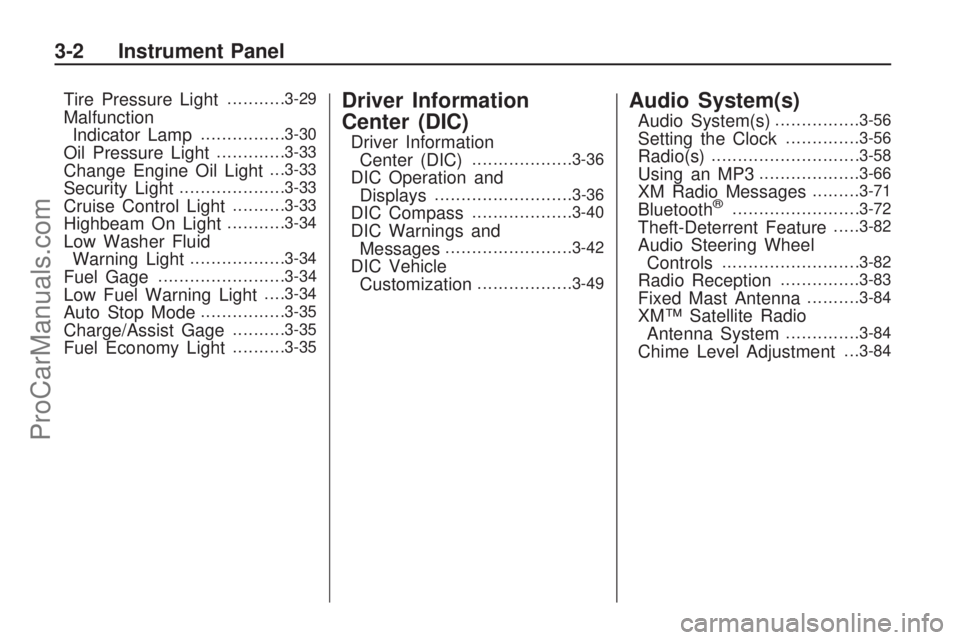
Tire Pressure Light...........3-29
Malfunction
Indicator Lamp................3-30
Oil Pressure Light.............3-33
Change Engine Oil Light. . .3-33
Security Light....................3-33
Cruise Control Light..........3-33
Highbeam On Light...........3-34
Low Washer Fluid
Warning Light..................3-34
Fuel Gage........................3-34
Low Fuel Warning Light. . . .3-34
Auto Stop Mode................3-35
Charge/Assist Gage..........3-35
Fuel Economy Light..........3-35
Driver Information
Center (DIC)
Driver Information
Center (DIC)...................3-36
DIC Operation and
Displays..........................3-36
DIC Compass...................3-40
DIC Warnings and
Messages........................3-42
DIC Vehicle
Customization..................3-49
Audio System(s)
Audio System(s)................3-56
Setting the Clock..............3-56
Radio(s)............................3-58
Using an MP3...................3-66
XM Radio Messages.........3-71
Bluetooth®........................3-72
Theft-Deterrent Feature.....3-82
Audio Steering Wheel
Controls..........................3-82
Radio Reception...............3-83
Fixed Mast Antenna..........3-84
XM™ Satellite Radio
Antenna System..............3-84
Chime Level Adjustment. . .3-84
3-2 Instrument Panel
ProCarManuals.com
Page 107 of 346
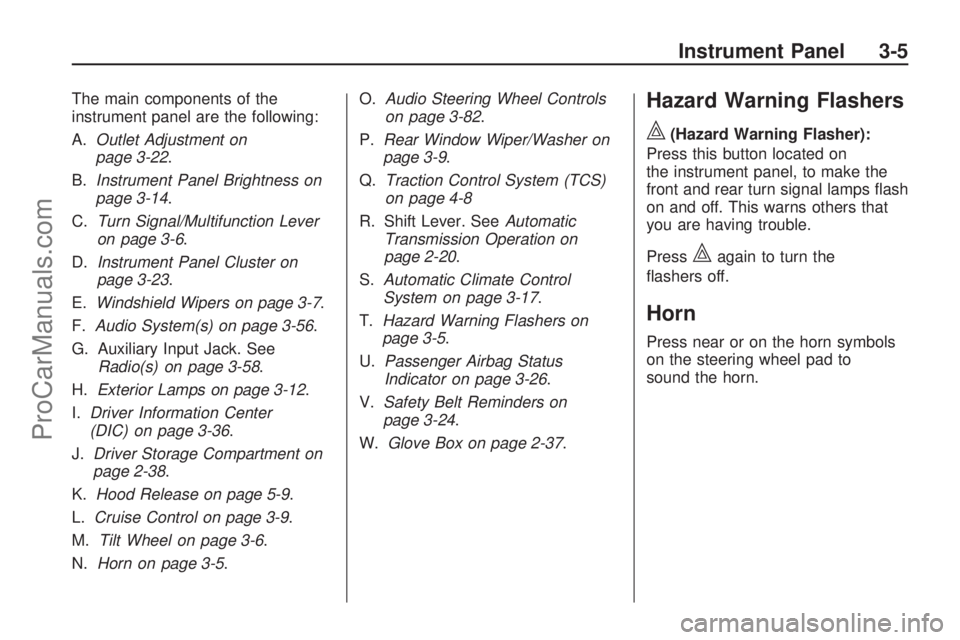
The main components of the
instrument panel are the following:
A.Outlet Adjustment on
page 3-22.
B.Instrument Panel Brightness on
page 3-14.
C.Turn Signal/Multifunction Lever
on page 3-6.
D.Instrument Panel Cluster on
page 3-23.
E.Windshield Wipers on page 3-7.
F.Audio System(s) on page 3-56.
G. Auxiliary Input Jack. See
Radio(s) on page 3-58.
H.Exterior Lamps on page 3-12.
I.Driver Information Center
(DIC) on page 3-36.
J.Driver Storage Compartment on
page 2-38.
K.Hood Release on page 5-9.
L.Cruise Control on page 3-9.
M.Tilt Wheel on page 3-6.
N.Horn on page 3-5.O.Audio Steering Wheel Controls
on page 3-82.
P.Rear Window Wiper/Washer on
page 3-9.
Q.Traction Control System (TCS)
on page 4-8
R. Shift Lever. SeeAutomatic
Transmission Operation on
page 2-20.
S.Automatic Climate Control
System on page 3-17.
T.Hazard Warning Flashers on
page 3-5.
U.Passenger Airbag Status
Indicator on page 3-26.
V.Safety Belt Reminders on
page 3-24.
W.Glove Box on page 2-37.Hazard Warning Flashers
|
(Hazard Warning Flasher):
Press this button located on
the instrument panel, to make the
front and rear turn signal lamps �ash
on and off. This warns others that
you are having trouble.
Press
|again to turn the
�ashers off.
Horn
Press near or on the horn symbols
on the steering wheel pad to
sound the horn.
Instrument Panel 3-5
ProCarManuals.com
Page 108 of 346

Tilt Wheel
The tilt lever lets the steering wheel
be adjusted.
The tilt lever is located on the left
side of the steering column.
To adjust the steering wheel, hold
the wheel and push the lever down.
Then move the wheel to a
comfortable position and pull the
lever up �rmly to lock the steering
column in place.
Turn Signal/Multifunction
Lever
The lever on the left side of the
steering column includes:
G:Turn and Lane-Change
Signals
3:Headlamp High/Low-Beam
Changer
Flash-to-Pass Feature.
Information for these features is on
the pages following.
Turn and Lane-Change
Signals
An arrow on the instrument panel
cluster �ashes in the direction of the
turn or lane change.
Move the lever all the way up or
down to signal a turn.
Raise or lower the lever until the
arrow starts to �ash and then
release, to signal a lane change.
The turn signal �ashes automatically
three times.
The lever returns to its starting
position whenever it is released.
If after signaling a turn or lane
change the arrow �ashes rapidly or
does not come on, a signal bulb
may be burned out.
3-6 Instrument Panel
ProCarManuals.com
Page 111 of 346

Rear Window
Wiper/Washer
The rear wiper and rear wash
button is located on the instrument
panel above the climate control
system.
=(Rear Wiper/Washer):Press to
wash and wipe the rear window.
The rear window washer uses
the same reservoir as the windshield
washer. Check the windshield
washer reservoir level if the front
windshield can be worked, but
no �uid is sprayed when the rear
washer is activated. SeeWindshield
Washer Fluid on page 5-24.
5(Delay):Press to turn the
delayed wiping on or off.
Cruise Control
With cruise control, the vehicle can
maintain a speed of about 25 mph
(40 km/h) or more without keeping
your foot on the accelerator.
Cruise control does not work at
speeds below 25 mph (40 km/h).
For vehicles with the StabiliTrak
®
system that begins to limit wheel
spin while you are using cruise
control, the cruise control will
automatically disengage. See
StabiliTrak
®System on page 4-7.
{CAUTION
Cruise control can be dangerous
where you cannot drive safely at a
steady speed. So, do not use the
cruise control on winding roads or
in heavy traffic.
Cruise control can be dangerous
on slippery roads. On such roads,
fast changes in tire traction can
cause excessive wheel slip, and
you could lose control. Do not use
cruise control on slippery roads.
Instrument Panel 3-9
ProCarManuals.com
Page 112 of 346
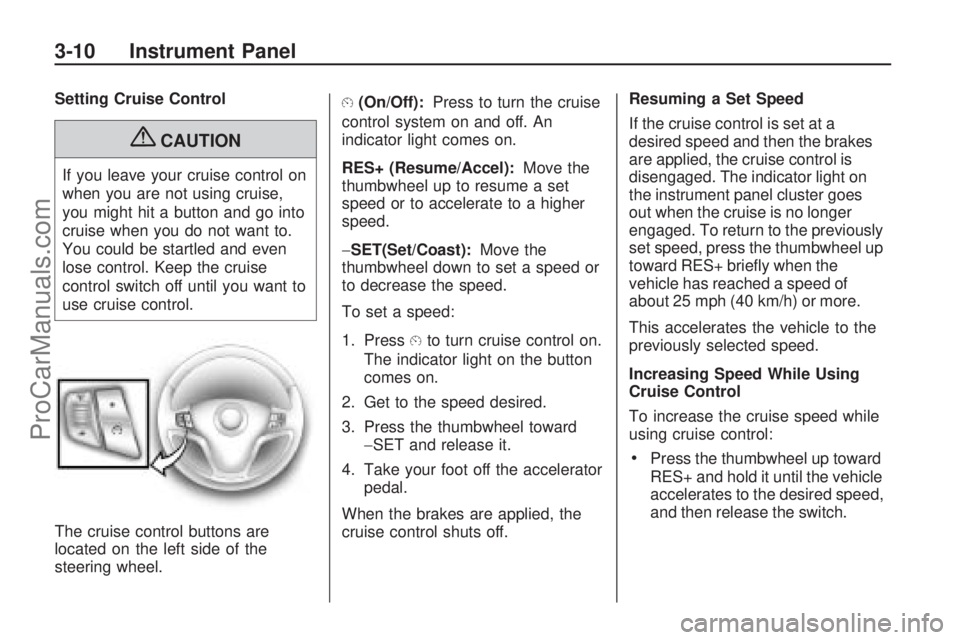
Setting Cruise Control
{CAUTION
If you leave your cruise control on
when you are not using cruise,
you might hit a button and go into
cruise when you do not want to.
You could be startled and even
lose control. Keep the cruise
control switch off until you want to
use cruise control.
The cruise control buttons are
located on the left side of the
steering wheel.
E(On/Off):Press to turn the cruise
control system on and off. An
indicator light comes on.
RES+ (Resume/Accel):Move the
thumbwheel up to resume a set
speed or to accelerate to a higher
speed.
−SET(Set/Coast):Move the
thumbwheel down to set a speed or
to decrease the speed.
To set a speed:
1. Press
Eto turn cruise control on.
The indicator light on the button
comes on.
2. Get to the speed desired.
3. Press the thumbwheel toward
−SET and release it.
4. Take your foot off the accelerator
pedal.
When the brakes are applied, the
cruise control shuts off.Resuming a Set Speed
If the cruise control is set at a
desired speed and then the brakes
are applied, the cruise control is
disengaged. The indicator light on
the instrument panel cluster goes
out when the cruise is no longer
engaged. To return to the previously
set speed, press the thumbwheel up
toward RES+ brie�y when the
vehicle has reached a speed of
about 25 mph (40 km/h) or more.
This accelerates the vehicle to the
previously selected speed.
Increasing Speed While Using
Cruise Control
To increase the cruise speed while
using cruise control:
Press the thumbwheel up toward
RES+ and hold it until the vehicle
accelerates to the desired speed,
and then release the switch.
3-10 Instrument Panel
ProCarManuals.com
Page 113 of 346

To increase the speed in small
amounts, press the thumbwheel
up toward RES+ brie�y and then
release it. Each time this is done,
the vehicle goes about 1 mph
(1.6 km/h) faster.
Use the accelerator pedal to
reach the desired speed
and press the thumbwheel
towards−SET. The new desired
speed must be greater than
the previous set speed by
typically 5 mph.
Reducing Speed While Using
Cruise Control
If the cruise control system is
already engaged,
Push the thumbwheel toward
−SET and hold until the desired
lower speed is reached, then
release it.
To slow down in very small
amounts, push the thumbwheel
toward−SET brie�y. Each time
this is done, the vehicle goes
about 1 mph (1.6 km/h) slower.Passing Another Vehicle While
Using Cruise Control
Use the accelerator pedal to
increase the vehicle’s speed. When
you take your foot off the pedal,
the vehicle will slow down to
the previously set cruise control
speed.
Using Cruise Control on Hills
How well the cruise control works on
hills depends upon the vehicle’s
speed, load, and the steepness of
the hills. When going up steep
hills, you might have to step on the
accelerator pedal to maintain the
vehicle’s speed. When going
downhill, you might have to brake or
shift to a lower gear to maintain
the vehicle’s speed. For some
vehicles the transmission may
automatically downshift when going
down hills to help maintain the
vehicle’s speed. When the brakes
are applied the cruise control
shuts off.Ending Cruise Control
There are three ways to disengage
the cruise control:
Step lightly on the brake pedal or
clutch; when cruise control
disengages, the indicator light on
the instrument panel cluster
goes out.
PressEto turn off the cruise
control system.
Erasing Speed Memory
The cruise control set speed memory
is erased when the cruise control or
the ignition is turned off.
Instrument Panel 3-11
ProCarManuals.com
Page 114 of 346

Exterior Lamps
The exterior lamp control is located
on the instrument panel to the
left of the steering wheel.
The exterior lamp control can be
turned to the following positions:
9(Off):Turns off the exterior
lamps. The knob returns to
the AUTO position after it is
released.AUTO (Automatic):Automatically
turns the exterior lamps on and
off, depending on outside lighting.
;(Parking Lamps):Turns on the
parking lamps together with the
following:
Sidemarker Lamps
Taillamps
License Plate Lamps
Instrument Panel Lights
2(Headlamps):Turns on the
headlamps, together with the
previously listed lamps and lights.
Lamps On Reminder
A warning chime sounds, if the driver
door is opened while the ignition is
off and the lamps are on.
Wiper Activated
Headlamps
This feature automatically turns
on the headlamps and parking
lamps if the exterior lamp control is
set in the AUTO position and the
windshield wipers are turned on and
have completed eight wipe cycles.
SeeExterior Lamps on page 3-12
for additional information.
When the ignition is turned off,
the wiper-activated headlamps
immediately turn off. They also turn
off if the windshield wiper control
is turned off.
3-12 Instrument Panel
ProCarManuals.com